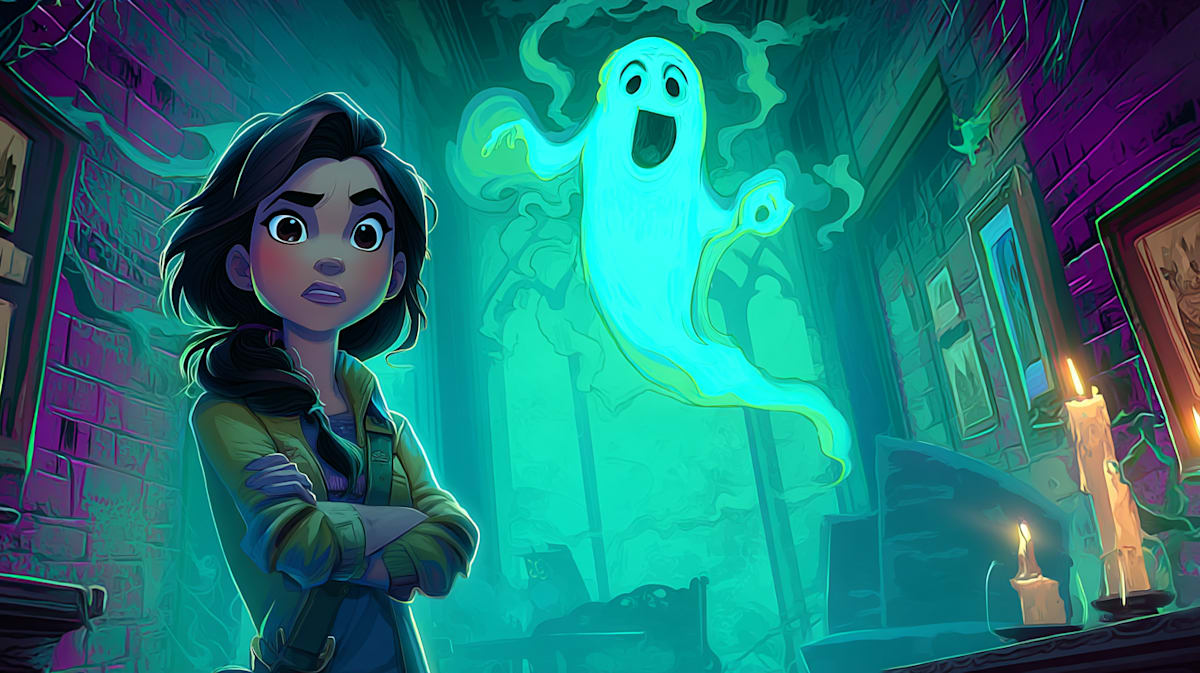Some people pack holy water, silver bullets, or sage bundles when heading into a haunted house. Maggie Hawkins, heroine of The Haunting of Crumbleton Manor, packs something far more dangerous: sarcasm. While most ghost hunters would be fumbling with salt circles, Maggie is rolling her eyes and muttering snark under her breath—and somehow, it works.
At first glance, this looks like pure comedy. After all, who fights a centuries-old wraith with a wisecrack about modern technology? But humor has always had power in folklore and, as it turns out, modern neuroscience backs this up. Sarcasm doesn’t just deflate egos; it can actually help humans (and readers) face fear.
Let’s unpack why wit has been humanity’s most underappreciated ghost repellent since time immemorial.
Humor vs. Horror in Folklore
Folklore brims with tales where wit outsmarts the supernatural. Celtic trickster figures often survived encounters with spirits not through brute strength but by playing clever word games or delivering a laugh at just the right moment. In Irish stories, laughter itself was thought to “break the spell,” snapping people out of enchantment or keeping faeries at bay.
There’s a reason for this: humor disrupts fear. A ghost’s whole job is to unsettle, to rattle, to make you doubt the safety of the space you’re standing in. But when you laugh—when you roll your eyes or throw back a sarcastic jab—you’ve flipped the script. You’re not the trembling victim; you’re the heckler in the cheap seats, refusing to take the performance seriously.
And here’s where folklore and neuroscience shake hands.
The Brain on Fear and Laughter
When something frightening happens, the amygdala—the brain’s threat detector—goes on red alert. That triggers the body’s fight-or-flight response: heart racing, adrenaline spiking, a sudden urge to flee the drafty hallway.
But humor brings in another player: the prefrontal cortex. That’s the brain’s logic and reframing center. Crack a joke at the ghost’s expense, and suddenly your brain is labeling the situation as less dangerous. Psychologists call this “cognitive reappraisal”—the ability to reframe a terrifying event into something manageable.
The reward system joins in, too. Shared laughter releases dopamine, the brain’s “feel-good” chemical, making us feel safer and more in control even in the middle of fear. In other words, sarcasm doesn’t just chase away ghosts—it tricks your own brain into saying, “We’re fine. This isn’t doom. This is stand-up comedy night.”
Maggie Hawkins: Patron Saint of Sarcasm
This is exactly why Maggie thrives in Crumbleton Manor. She refuses to play the role of terrified victim. Instead of bowing to the theatrics of spectral nobility or running from shadowy wraiths, she treats them like bad performers in need of a reality check.
By doing so, she shifts the balance of power. The ghosts expect screams, fainting, and trembling. What they get instead is someone unimpressed with their special effects. It’s not that the manor is less haunted—it’s that Maggie refuses to let the haunting define her experience. Her brain (and ours, as readers) is being cued to laugh instead of panic, which makes the whole spectacle even more delightful.
Folkloric Echoes in Crumbleton Manor
Crumbleton’s cast of ghosts is practically a case study in why humor works. The dramatic Victorian lady can be deflated with a single sarcastic jab. The sarcastic 1920s gentleman ghost is a mirror of Maggie’s own snark, showing how humor can build camaraderie as well as protection. Even the wraith, intended to be the embodiment of terror, ends up flustered when treated more like a Wi-Fi outage than a harbinger of doom.
This mirrors centuries of stories where spirits were undone by laughter or clever retorts. The difference is that Maggie brings it into the twenty-first century, showing that sarcasm is as effective as any ancient charm—possibly more so.
Why Readers Love Snarky Survivors
There’s a reason sarcastic survivors have become beloved archetypes in horror and fantasy. Watching a character joke in the face of terror gives us permission to laugh, too. Neuroscience tells us that shared humor triggers reward pathways in the brain, making us feel more connected and less threatened.
It’s catharsis in two directions: the amygdala is screaming, but the prefrontal cortex is laughing, and the dopamine says, “Do that again.” Readers don’t just want to be scared—they want to be entertained. And what’s more entertaining than a heroine who treats a haunting like open-mic night?
Closing Thoughts
Haunted houses thrive on fear, but sarcasm thrives on cutting fear down to size. Humor shifts the power dynamic, helping both characters and readers process the spooky, the eerie, and the absurd. Maggie Hawkins may never get a ghost-hunting manual written in her honor, but she’s proof that sometimes the sharpest tool in the kit is a sharp tongue.
If you’d like to experience Crumbleton Manor’s ghosts, wraiths, and one heroine armed with enough sarcasm to make the dead roll their eyes, you can find The Haunting of Crumbleton Manor on Kindle Unlimited: https://a.co/d/bb4WfaB
And remember: when the spirits rise, don’t scream—snark.
